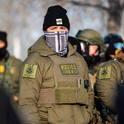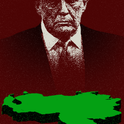The Republican ascendancy in US politics has been hailed by supporters at home and abroad as an historic shift that will fulfil Speaker Newt Gingrich's promise "to replace the welfare state with the conservative opportunity society." Less than three years earlier the electoral victory of Bill Clinton, defeating an incumbent president and installing the first Democrat in the White House for 12 years, was hailed as a similarly historic success for a revitalised Democratic party, invigorated by a modernised concept of American social democracy.
The Zeitgeist, or at least the fashionable interpretation of deeper political currents, can change fast in the information age. And yet, as we might expect from two baby-boomers from broken homes who somehow avoided the Vietnam war, whose only jobs were university lecturing and elected office, and who each owns the same private car (a 1966 Ford Mustang convertible), the Clinton and the Gingrich visions have some common features.
Neither one could abide the classic foreign policy presidency of George Bush. Each built his political appeal on the promise of a middle class tax cut, to be financed through a diminished and "re-invented" government bureaucracy, with Americans educated and challenged to compete in the bracing new world of the global economy. Each believes in an activist government. In the Clinton view, it has a duty to equip the public with the educational tools to succeed; in the Gingrich view, to steer them towards the moral values without which success has no meaning. Clinton would intervene in the schools and economy, Gingrich in the private lives of welfare mothers and the history curriculum of the schools.
Some of these common threads suggest that something more fundamental is at work than merely a conventional shift in the balance of power from left to right, or from an activist concept of government to a shrunken one.
One of the most distinctive rhythms of American political history has been the tidal flow of power from White House to Congress and back again. If the usual business of government was shared in creative but often uneasy tension between the two, crisis always strengthened the presidential hand. From the presidencies of Jackson and Lincoln and Teddy Roosevelt and Woodrow Wilson, a clear pattern emerges of military, economic or political crisis becoming the occasion of a shift in the balance of power from the Capitol to the White House. But the power subsequently shifted back again. The successors to those four presidents, Martin Van Buren and Andrew Johnson, William Howard Taft and Warren Harding, are not names associated with any great assertion of presidential power.
The striking feature of the last six decades-the era which saw the emergence of what Arthur Schlesinger called the imperial presidency-is that the crises never stopped. For over five decades the tide of power did not wash back again up Pennsylvania Avenue to the Capitol. The Great Depression led into the second world war, which led in turn to the cold war. These three challenges, each threatening the very existence and character of the American state, flowed almost seamlessly from one crisis to the next, and legitimised the era of big government.
Until 1939, "White House staff" had meant little more than the household servants. The president had authority to hire only four staff aides above clerical rank. From these humble beginnings a giant bureaucratic edifice was to grow-the privy court of the imperial presidency. By 1942, with the appointment of Admiral Leahy, the White House office had spawned its first chief of staff. By 1945, Franklin Roosevelt had 11 administrative assistants. Harry Truman had 13. Dwight Eisenhower had 37. By 1972, Richard Nixon had 48. The executive office staff, which had swollen to 1,175 during Eisenhower's first term, grew to 1,164 under President Kennedy, and to 5,395 under President Nixon. This mass of political courtiers was but the most intimate layer of a growing federal bureaucracy, the machinery of big government.
The Bureau of the Census reports that the total number of federal employees in 1940 was 1,128,000. By 1945, under the strains of global war, their numbers had tripled to 3,496,000. By 1950 they had shrunk somewhat, to 2,117,000, but then their ranks thickened: 2,421,000 in 1960; 2,881,000 in 1970. Under President Ronald Reagan, that inveterate foe of big government, the federal bureaucracy again topped the 3 million mark, in 1985.
Beyond these raw numbers, the balance of political power was shifted towards the White House by the strategic nature of new institutions that were devised to help the presidency meet the challenges of the cold war. President Truman's establishment, in 1947, of the National Security Council and the Central Intelligence Agency brought new tools of executive authority under the president's own hand.
The extra power and resources that these new institutions brought stemmed not just from presidential ambition, but from a series of fundamentally transformed situations which the presidency had to face.
Of these, the most immediately dramatic was the development of the atomic bomb. Not only did it revolutionise the concept and the costs of warfare, it also imposed a new technological imperative upon the traditional responsibilities of the president as commander-in-chief, and upon those of the Congress, as the body with the constitutional authority to declare war. Memories of the sneak Japanese attack on Pearl Harbor were still fresh, and the prospect of a surprise nuclear strike on American targets was immeasurably more dreadful.
Consequently, the decision-making process became more urgent. As the nuclear balance developed in the 1950s and thereafter, the presidency required the powers to wage instant retaliatory war, without time for the constitutional niceties. The most potent symbol of presidential power became the omnipresent "football"-the deceptively sporty name for the briefcase which contained the nuclear codes.
In order to deal with non-nuclear military threats, the US accepted the need to change the habits of over 160 years, and maintain a large standing armed force in peacetime, based on conscription. By 1960 it comprised some 3 million army troops, airmen and sailors. They were deployed in far-flung garrisons-some 200 overseas bases by the time of the Kennedy administration-all locked into a series of alliances and treaty commitments and local political issues that often conflicted with the overriding strategy of containing the Soviet threat.
The size of cold war defence budgets hugely increased the presidential role in the overall economy, and went hand in hand with the prevailing Keynesian theories of the day to become a flywheel by which the activities of the broader economy could be slowed or speeded. Kennedy's re-armament programme after 1961 was financed on annual budget deficits of $6 billion. By the 1980s, the Reagan re-armament boom represented an almost pure form of military Keynesianism. In the 12 years of the Reagan-Bush presidencies, the US national debt quadrupled-from $1 trillion to $4 trillion. The difference, $3,000 billion, is close to the accumulated defence budgets of those years.
The president's powers over the economy were far from absolute. Congress had the power of the purse; the Federal Reserve Bank controlled interest rates. But federal government expenditure as a proportion of gross national product, which had been only 2 per cent in 1930, grew inexorably to about 20 per cent in 1965. The fact that the federal government became the dominant actor in the US economy did not in itself enhance the direct powers of the presidency. US governments had spent lavishly in crises before. But again, the distinction of the era of the imperial presidency was that the government's share of GNP no longer declined once the crisis had passed.
The cold war defined the modern presidency, and recast the job into the role of commander-in-chief of the free world. The rest of the world, in consequence, was to be almost as fascinated by the dramas of presidential elections as the Americans themselves. Self-interest reinforced the fascination, as crises in Berlin and Cuba reminded non-Americans that their existence-and the survival of organised life on the planet-hung on the president's judgement at the nuclear brink.
The great encounters of international life became those graced by the imperial president, usually at summit conferences with his only parallel, the master of the Kremlin. The president, newly enabled to travel far and fast by jet airliners, newly intimate to millions overseas through television, outgrew the US, just as the dominance of the American economy determined whether the rest of the world would enjoy boom or endure recession.
Perhaps the most telling anecdote of the period comes from President Johnson's visit to South Vietnam in 1966. Arriving at Tan Son Nhut airfield with its huge array of American air power, he was greeted by a young Air Force officer who said: "Your helicopter is this way, Mr President." Johnson gazed at the endless flight lines and replied: "Son, they're all my helicopters."
In the US and among America's allies and its former enemies alike, we have all grown so accustomed to this presidential greatness that it is not immediately apparent that it rings increasingly hollow. But in the aftermath of the cold war, it is clear that the US's existence is no longer threatened. In the 1990s, there is no Great Depression to require emergency powers. There is no world war, and no cold war substitute, and no nuclear missiles are now poised and targeted at American cities. In the absence of mortal threat, the question arises: what is the need for big government?
"I am determined to get to a smaller federal government. I am determined to return power to the states and local governments and to private citizens," declared Newt Gingrich as he became the first Republican Speaker of the House of Representatives for 40 years. Asked which government departments would remain inviolate from the Republican axe, Gingrich was notably succinct: "Treasury, state, Attorney-General, defence. Outside of that, you ought at least to look at them and say: why?"
Bill Clinton is not fighting hard to preserve the swollen apparatus of the presidency and the federal government. The Republicans want to slash federal discretionary spending by a third to balance the budget within seven years. Clinton held out for ten, to the dismay of his party in Congress. It was not quite as definitive a transfer of power as the eerie moment when Mikhail Gorbachev returned from house arrest in the Crimea to find a triumphant Boris Yeltsin stabbing his finger on a paper and saying "Sign here." But the tide had turned, and power is beginning visibly to flow from White House back to Congress.
Success in the cold war was achieved less by the military and diplomatic achievements of the imperial presidency, than by its rallying of a wholly new international economic structure to the cause. The rebuilding of western Europe through the Marshall Plan, and of Japan during the Korean war, with the Pentagon's equally generous special procurements budgets, was the most abiding strategic achievement of the cold war presidents.
When the American economy faltered, as it did in the 1980s, the European and Japanese economies, which American policy had cultivated, were able to take up the slack. In the process-and barely understanding what was accumulating before their eyes-the three components of the west created (like Dr. Frankenstein) a new and self-generating global force which was beyond their power to control. We can already argue that the real significance of the cold war, which has dominated the lives of most people now alive, has been to play the role of catalyst in the creation of the global economy which will dominate our future.
This process of globalisation is now being deliberately accelerated by that least imperial of presidents, Bill Clinton, who is likely to go down in history as the free trade president. The credit is not his alone; Clinton is completing the unfinished agenda of George Bush, who began the North American Free Trade Agreement, and the US push for the Asia-Pacific Economic Conference. Bush's team also did the heavy lifting for the Gatt world trade pact through the Blair House agreement on agricultural subsidies with the European Community, .
But President Clinton has taken the process further than the Bush team. To the degree that we can already discern a Clinton doctrine, it is to lock the US into the heart of each of the three great new trading blocks which make up the global economy. Even before he began campaigning for the White House, Clinton used to muse about the way the old geo-political and geo-strategic world of the cold war was giving way to a new era of geo-economics and geo-finance, which were marked by trade pacts.
Margaret Thatcher had warned, at the 1990 G-7 economic summit in Houston, of the dangers of a world dividing into three competing currency blocks: the dollar, the yen and the Deutschmark. She feared that such economic competition could lead in time to strategic rivalry. The elegance of Clinton's economic diplomacy is to fend off such an outcome, by locking the US into the heart of each one.
This may be the last act of the imperial presidency as we have known it in the 60 years since the US's long crisis began with the Great Depression. Free trade-by definition-weakens government power, and erodes the economic authority of the nation state. The power of governments to regulate the currency, to control or tax trade, to direct the investment of its businessmen, or even to impose the authority of its national laws, are all explicitly cut back by the powers granted to the new World Trade Organisation established by the 1994 Gatt agreement.
So the real shift in the balance of power may not be the traditional post-crisis flow from White House to Congress which took place after the American civil war and after the first world war, but a new shift, from Washington to the amorphous and inscrutable global markets, to Adam Smith's "invisible hand" in a new and transnational dimension.
This is a process whose effects and implications go far beyond America. But America's Japanese and European allies are likely to find this new era of blurring and diluted national sovereignty less of a shock because they are more accustomed to it. The Japanese and Europeans have learned to subordinate their foreign policies to the American leader of the alliance. European countries have learned to modify their laws and farming and taxation policies to accord with the requirements of the European Union.
The imperial presidents were not only the commanders-in-chief of the free world, they had also to play a unifying role at home as fathers of the nation, uniquely empowered to assert a national interest. If recent social disparities continue to widen in the new world order of free trade, then the imperial president might well be summoned again. He would come, not as an international authority, but as the domestic saviour, much as Franklin Roosevelt was elected to lead the way out of the domestic emergency which launched the imperial presidency.
Alternatively, new external threats, whether from a still nuclear Russia or an enriched and modernised China, might reinstate the president's authority. The familiar tidal rhythm of power would then flow back again to the White House. Like Barbarossa, the imperial presidency may only be sleeping.
The end of the imperial presidency
The frantic swings in American political life over the past five years have perplexed the world. Martin Walker sees them as symptoms of a bigger shift in the balance of power following the end of the cold war
November 20, 1995











